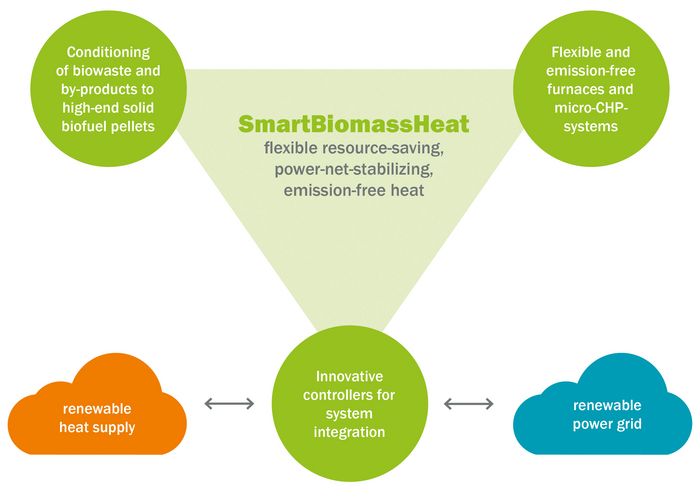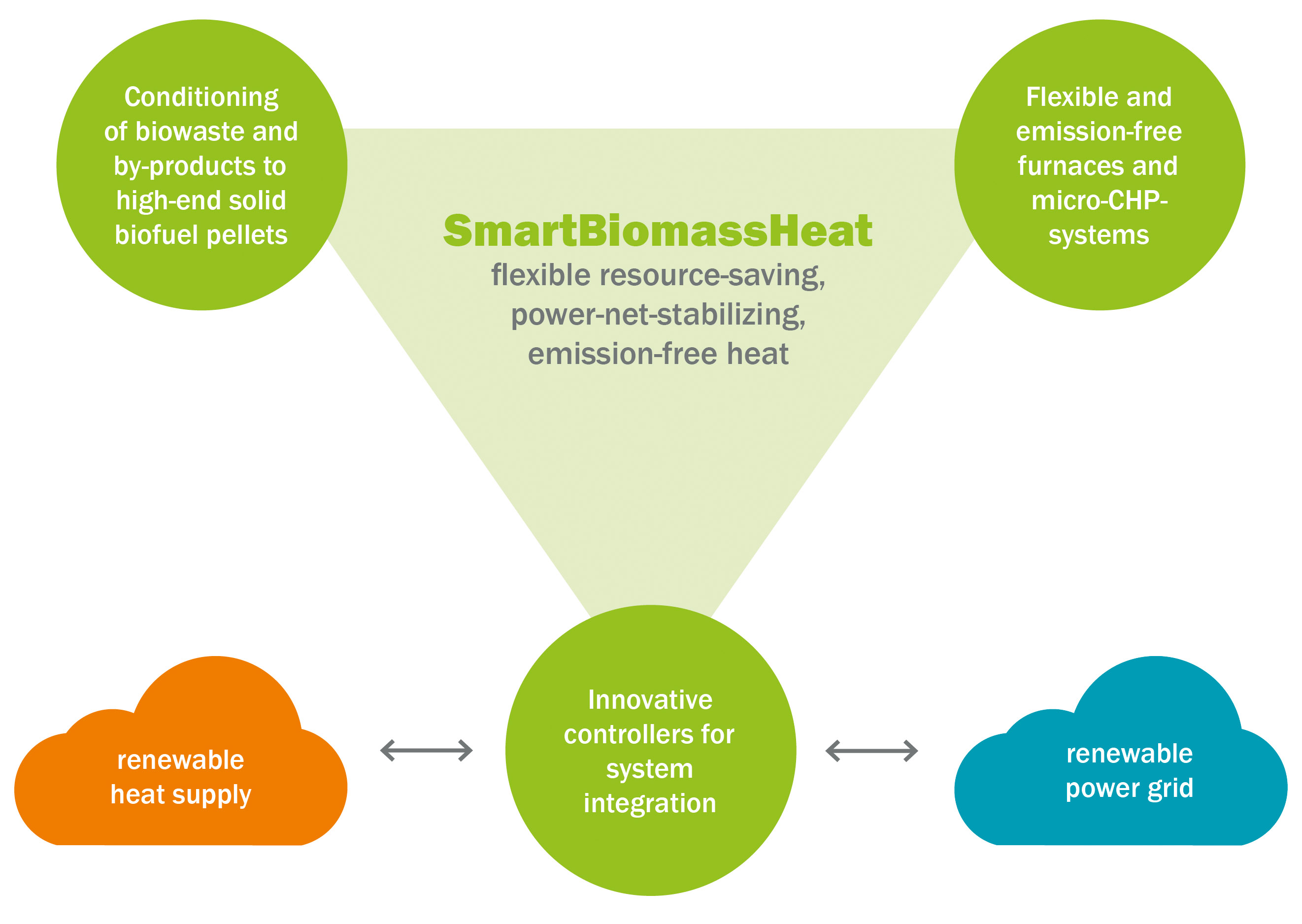SmartBiomassHeat
"Future heat supply from biogenic solid fuels must become much more efficient, flexible and tailored to system requirements – it needs to get smarter!"
Dr. Volker Lenz, Head of the research focus area
Objective
This research focus area concentrates on small-scale, renewable heat production in single units and small combinations up to village or town neighbourhood scale using intelligent heat technologies interlinking other renewable energy sources and based on biomasses primarily originating from residues, by-products and wastes. The primary aim is to make optimal technological and economic use of all renewable heat resources based on flexible, demand-adapted deployment of heat technologies based on biomass. This involves mapping the entire chain from grafting of the biomass fuels through new conversion plants to integration into the heat and power grid of the biomass heaters (executed in future also as combined heat and power plants), analysing, simulating and optimising them individually and collectively. It will also entail the necessary technical component development and linking control research and development through flexible operation (including micro- and small-scale CHP) to achieve efficient, environmentally friendly, economical, safe, demand-adapted, flexible and sustainable (smart) operation (SmartBiomassHeat).
Background
There is a global consensus that the current ongoing climate change is a result of greenhouse gas emissions caused by human activity [1]. Accordingly, at the Paris climate conference in December 2015, 195 countries adopted the first-ever universal, legally binding global climate agreement. The long-term goal is to keep the increase in global average temperature to well below 2°C above pre-industrial levels. As a preventive measure, limiting the increase to 1.5 °C will even be targeted [2]. Consequently, by 2050 Germany will have to reduce its emissions of greenhouse gases by between 80 and 95% relative to the reference year 1990, largely or even completely abandoning the use of coal, gas and oil as energy supply sources in order to do so. This is the stated aim of the German Federal Government [3]. It is undisputed that wind and solar power will have to cover most of Germany's future energy needs. Owing to the short-term and seasonal fluctuations in those sources, an economic optimum between overcapacity entailing corresponding shutdown times, short-, medium- and long-term energy storage options and the flexible use of biomass as an energy source will have to be found [4]. This must incorporate the centralised electricity supply sector as well as the heat and mobility sectors.
There is forecast to be a significant reduction in demand for building heating by 2050 (at least 50%) as a result of insulation measures [5]. In the mobility sector, electricity ("e-mobility") or motor fuels produced from electricity will increasingly be used (see, for example, Nitsch 2016 [6]). Energy supply from biomass will have to focus on biogenic residues, waste and by-products [7]. At the same time, it will have to be deployed flexibly as a fundamentally storable energy form in order to cover gaps in supply [4],[8]. Consequently, from a present-day viewpoint two key supply concepts for the heat sector arise, alongside the conceivable diversity of individual solutions in future [9].
SmartBiomassHeat
Peak-load furnaces: Particularly in detached and semi-detached homes, or in high-end apartment blocks, automated firewood (and pellet) fuelled furnaces with integrated flue gas cleaning, automatic air control and water tanks connected to the central heat supply in combination with heat pumps, and possibly solar plants, will largely be used.
Micro and miniature combined heat and power plants: Where there is a certain residual level of annual heat demand after deducting potential heat contributions from waste heat sources, heat pumps, solar plants, geothermal energy and surplus electricity, micro and miniature combined heat and power plants will replace conventional biomass boilers [10]. To achieve maximum efficiency and benefit from the valuable biomass resources, the plants will be run so that the heat produced can be utilised fully to cover gaps in heat supply as and when they occur, with a few days' flexibility of production timing based on suitable buffer storage of the heat. At the same time, the stability of the power grid must be supported as efficiently as possible - meaning the actual operating time will be based on the power demand in the building/neighbourhood/local supply grid.
Outlook
The research topics seek, firstly, to make single-chamber furnaces fit for the future based on continuous development, including the regular bringing to market of products in conjunction with industry. Secondly, they seek to achieve a technology leap in biomass boilers towards highly flexible combined heat and power plants even in the low and ultra-low output range for biogenic solid fuels.
Sources:
- Intergovernmental panel on climate change (IPCC): Climate Change 2014, Synthesis Report. Summary for Policymakers. www.de-ipcc.de/media/SYR_AR5_SPM.pdf (Zugriffsdatum:30.03.2015)
- Klimaretter.info: Pariser Klimaabkommen. Ein Blick in die Paragrafen. Das Magazin zur Klima- und Energiewende. 12. Dezember 2015 www.klimaretter.info/klimakonferenz/klimagipfel-paris/hintergrund/20315-ein-blick-in-die-paragrafen (Zugriffsdatum: 17.04.2016)
- Bundesministerium für Umwelt, Naturschutz, Bau und Reaktorsicherheit (BMU): Aktionsprogramm Klimaschutz 2020. Kabinettsbeschluss vom 3. Dezember 2014.
- D. Thrän (Hrsg.): Smart Bioenergy, Technologies and concepts for a more flexible bioenergy provision in future energy systems. Springer International Publishing. Switzerland, 2015
- Bundesministerium für Verkehr, Bau und Stadtentwicklung (BMVBS): Bestandsaufnahme zur Energie- und Klimaschutzentwicklung – Monitor 2012 / Gebäude und Verkehr. Berlin, März 2013
- J. Nitsch, Die Energiewende nach COP 21 – Aktuelle Szenarien der deutschen Energieversorgung, Kurzstudie für den Bundesverband Erneuerbare Energien e.V. 2016
- CDU Deutschlands, CSU-Landesleitung und SPD: Deutschlands Zukunft gestalten. Koalitionsvertrag zwischen CDU, CSU und SPD. 18. Legislaturperiode 12/2013
- D. Thrän, M. Dotzauer., V. Lenz, J. Liebetrau, A. Ortwein: Flexible bioenergy supply for balancing fluctuating renewables in the heat and power sector – a review of technologies and concepts. In Energy, Sustainability and Society. Springer Open Journal. 2015
- Lenz, V., Krüger, D., Ortwein, A. (2016). SmartBiomassHeat – Heat from solid biofuels within a future renewable energy system. CIT. Submitted 14 April 2016
- Renewable Heating & Cooling European Technology Platform: Biomass für heating & cooling. Vision document – executive summary. July 2010
- Hochschule Zittau/Görlitz: Beiträge zum Fachkolloquium "Biomass to Power and Heat". Tagungsband mit Autorenbeiträgen. Zittau, 06.-07. Mai 2015
Important reference projects (Selection)
- REFAWOOD – ERA-NET Bioenergy: Ressourceneffiziente Brennstoffadditive zur Verringerung der verbrennungstechnischen Probleme bei der Rest- und Gebrauchtholzverbrennung, ERA-NET/Fachagentur Nachwachsende Rohstoffe e. V., 01.04.2016–31.03.2019 (FKZ: 22404215)
- STEP – Verwertung strohbasierter Energiepellets und Geflügelmist in Biogasanlagen mit wärmeautarker Gärrestveredlung; Teilvorhaben: Verbesserung der Verbrennungseigenschaften projektspezifischer Gärreste, Bundesministerium für Wirtschaft und Energie/Projektträger Jülich, 01.08.2016–31.01.2019 (FKZ: 03KB116B)
- Dampf-KWK – Entwicklung eines Klein-KWK-Dampfmotors zur Nachrüstung von Feuerungsanlagen im mittleren Leistungsbereich, Bundesministerium für Wirtschaft und Energie/Projektträger Jülich, 01.07.2016–30.06.2019 (FKZ: 03KB118A)
- UFOKFA - Evaluierung der 1. BImSchV von 2010, UBA - Umweltbundesamt, 01.12.2017 - 31.10.2018
Important publications (Selection)
- Açikkalp, E.; Zeng, T.; Ortwein, A.; Burkhardt, H.; Klenk, W. (2018). "Exergy, Exergoeconomic and Enviroeconomic Evaluation of a Biomass Boiler-Steam Engine Micro-CHP System". Chemical Engineering & Technology (ISSN: 0930-7516), Vol. 41, H. 11. S. 2141–2149. DOI: 10.1002/ceat.201800041.
- Pollex, A.; Zeng, T.; Khalsa, J. H. A.; Erler, U.; Schmersahl, R.; Schön, C.; Kuptz, D.; Lenz, V.; Nelles, M. (2018). "Content of potassium and other aerosol forming elements in commercially available wood pellet batches". Fuel (ISSN: 0016-2361), H. 232. S. 384–394. DOI: 10.1016/j.fuel.2018.06.001.
- Zeng, T.; Pollex, A.; Weller, N.; Lenz, V.; Nelles, M. (2018). "Blended biomass pellets as fuel for small scale combustion appliances: Effect of blending on slag formation in the bottom ash and pre-evaluation options". Fuel (ISSN: 0016-2361), H. 212. S. 108–116. DOI: 10.1016/j.fuel.2017.10.036.
- Sedlmayer, I.; Arshadi, M.; Haslinger, W.; Hofbauer, H.; Larsson, I.; Lönnermark, A.; Nilsson, C.; Pollex, A.; Schmidl, C.; Stelte, W.; Wopienka, E.; Bauer-Emhofer, W. (2018). "Determination of off-gassing and self-heating potential of wood pellets: Method comparison and correlation analysis". Fuel (ISSN: 0016-2361), Vol. 234. S. 894–903. DOI: 10.1016/j.fuel.2018.07.117.
- Kohler, H.; Ojha, B.; Illyaskutty, N.; Hartmann, I.; Thiel, C.; Eisinger, K.; Dambacher, M. (2018). "In situ high-temperature gas sensors: Continuous monitoring of the combustion quality of different wood combustion systems and optimization of combustion process". Journal of Sensors and Sensor Systems (ISSN: 2194-8771), Vol. 7, H. 1. S. 161–167. DOI: 10.5194/jsss-7-161-2018
- Purkus, A.; Gawel, E.; Szarka, N.; Lauer, M.; Lenz, V.; Ortwein, A.; Tafarte, P.; Eichhorn, M.; Thrän, D. (2018). "Contributions of flexible power generation from biomass to a secure and cost-effective electricity supply: a review of potentials, incentives and obstacles in Germany". Energy, Sustainability and Society (ISSN: 2192-0567), Vol. 8, H. 1. S. 18. DOI: 10.1186/s13705-018-0157-0.
Next section: » Catalytic emission control



